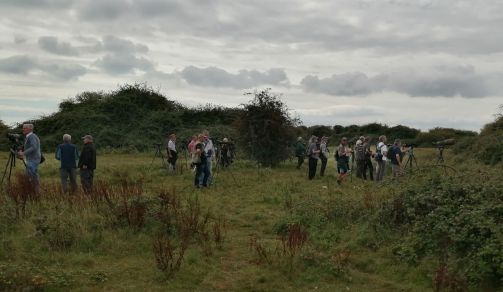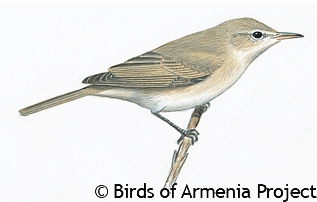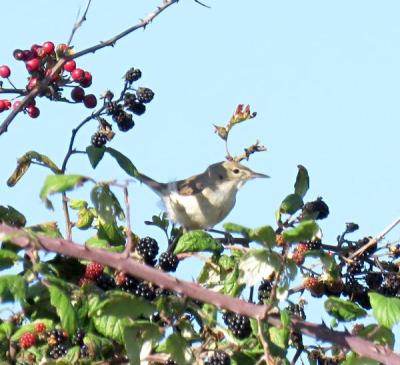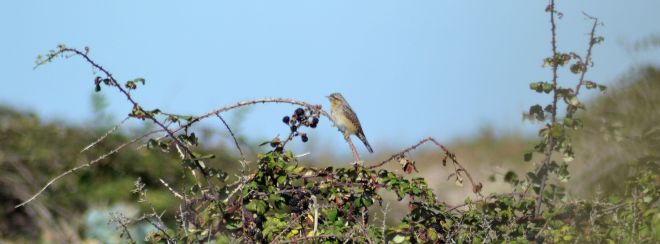This personal birding landmark was reached courtesy of the autumn’s first twitchable new passerine migrant within my preferred 150-mile range. The warbler in question was initially reported in the early afternoon of Saturday 14th, and being of national mega status and the first ever record for Hampshire drew large crowds over the weekend. But as it was a British tick for me and not a lifer I decided to wait and see whether it stayed until today.
When an early sighting came at 7:25am it was a huge relief to be hitting the road again after a dull opening to my personal autumn birding season in recent weeks. The weekend had aptly demonstrated the paucity of local birding in my home county with a required lifer Aquatic Warbler (briefly), Bluethroat (difficultly) and a number of Wrynecks all reported in the familiar (to me) area of southern Hants and Sussex featured in this post.

So it was that at 10:40am I arrived at Farlington Marshes Hants and IoW Wildlife Trust nature reserve (pictured above) in the north-west corner of the Langstone Harbour complex (SU 685045). The site is now rather more developed than when I used to visit fairly regularly in the late 1980s and early 1990s, with a metalled access road and two car parks, both of which were full. I joined around 50 or more birders who were staking out classic migrant landfall habitat in meadows at the reserve’s northern end.
It was at once apparent this would be an as classic warbler twitch, involving staring at banks of dense vegetation for long periods in the hope of brief glimpses of a skulking bird. As these RBA gallery pictures (here) show, Eastern Olivaceous Warbler is a strikingly pale looking Hippolais, especially on the underside, totally lacking in green tones, brownish-grey above and with greyish-white beneath. Lively in jizz and prone to keeping in tree cover, the species exhibits relatively plain wings, a bland face, pale supercilium and long yellow bill. It is very rare in Great Britain, with just 21 accepted previous records mostly on the northern isles, Scillies and eastern coasts.

Eastern Olivaceous Warbler
Over my next two hours on site here, various movements and glimpses were detected but there was no consensus amongst the gathered birders as to a positive ID. RBA posted a “showing well” sighting at 11:30am but nobody I then enquired of knew anything about it. I was keeping in touch throughout with Adam who had seen the bird on Sunday, and he now prompted RBA to consult the reporter who said he had actually meant 10:30 just before my arrival. That was the second time in the morning that a posting was quoted as “erroneous”.
It did seem a few birders considered they had seen the EOW at that time, but others felt they could easily have been mistaken. Shortly before 1pm I was joined by Ewan who had set off on the spur of the moment after an appointment at home. On realising that our quarry was being far more difficult to locate than a day earlier, we decided to move along the coast eastward to Church Norton near Bognor Regis to try for a Wryneck, and then return later.
Ewan said he knew the exact location for the second bird, the only one still present in the area from a day earlier, which was a part of the Pagham Harbour complex I was not familiar with. When we reached the “Severals”, an area of pools just to the harbour’s south-west (SZ 873950), six other birders were already scanning the location. Fairly soon one of them called that he had located the Wryneck in a bush close by.
We gained a good first view of this cryptically plumaged, regular autumn migrant on the ground, before walking around to the far end of the path concerned to try for a better one. The Wryneck then moved high into the same bush again and perched for a while surveying its surroundings (pictured above, left). Ironically the people we left probably had the best views at this time, amongst whom one lady got some rather better looking images on her phone.
Eventually this bird flew back towards the harbour, landing in some Gorse, and when they could not re-find it the other birders all left. But Ewan suggested we search for it again and we gained further views of the Wryneck in more open places. We had been joined by a local birder who had looked for it on each of the previous two days, and he was now especially pleased to see his quest. This success in relocating a personal fourth record at what is a regular passage site for the species was all due to my vastly experienced companion’s own field craft.
While we were at Church Norton there were more postings on RBA of the Eastern Olivaceous Warbler, accompanied by the birding notation “tho elusive”. Returning to Farlington Marshes we resolved to see out the local rush hour on-site while trying for that quest again. The earlier crowd had all moved on and up to 20 different birders now surrounded a particular thicket where presumably the bird had last been seen. As dusk drew in there were at length some positive if very fleeting observations.

Today’s bird a day earlier © and courtesy of Adam Hartley
I saw just enough to tick this bird, previously experienced in Greece and Turkey, for Blighty but at this point the sentiment from gaining my 350th British record was very flat. It was in there somewhere and kept being glimpsed near the top of the thicket. Would I get a better view as conditions continued to dim and became drizzly? It was difficult to know whether to stay in one place or walk around the other side as animation here or there on the part of some observers suggested the bird might be in view.
I did a circuit to find the EOW had popped it’s head out low down at the spot I had departed, making the diagnostic tongue clicking call, and my frustration grew. But finally in the failing light at around 18:45 I fixed my binoculars on a pale looking warbler that emerged in the top of some Elder and showed itself very well side on. A particular behavioural trait of this bird is to dip its tail downward when feeding, and having been noted earlier by some people around me was again apparent now.
“That’s it,” said Ewan to one side, and the sense of satisfaction that welled within me was altogether different. Not only had mission been truly accomplished but I could make a proper story of it for this journal too. “Well done. You’ve worked hard for that,” came Adam’s reply to my celebratory WhatsApp as I headed for home.

Footnote: A day later (17th), having been tasked for a while with locating a first Wryneck for another Oxon birding friend, Sally we returned to the Church Norton site. In bright, sunny conditions and in company with several other birders we watched the bird (above) on and off for a couple of hours. Over at Farlington the Eastern Olivaceous Warbler was said to have showed well for around 90 minutes, confirming that myself and Ewan had chosen a difficult day on which to experience that bird. The EOW was as showy a day later (18th) when Ewan re-visited (see here), and continued to be reported until 22nd though it’s actual departure date was cited as “unclear”.


